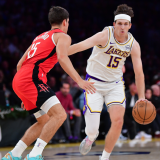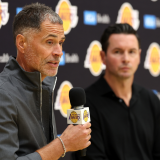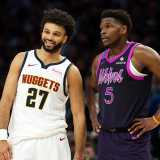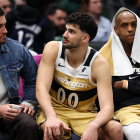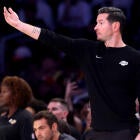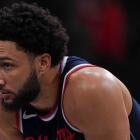
Should Jared Sullinger keep shooting 3s?
A look at offensive efficiency for the modern stretch four.
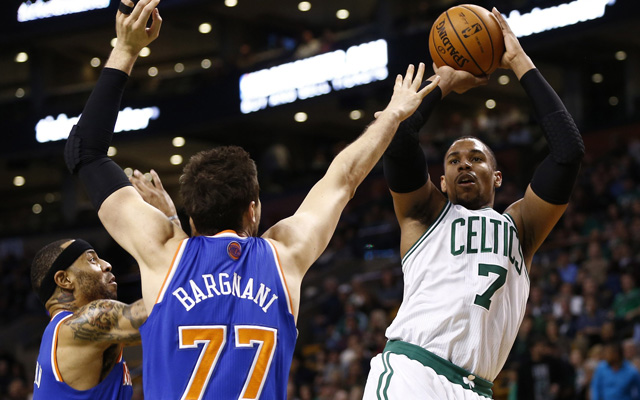
More NBA: Power Rankings | Expert Picks | Latest news, notes
Jared Sullinger is not a good 3-point shooter.
This is a subjective statement, but if you were to say "Jared Sullinger's 3-point percentage is considerably worse than the average percentage for a player who shoots the same volume behind the arc as he does" that would be objective, and both are true. He's bad at it.
I mean, check it out.
Ye Gods.
Among all players shooting at least 2.5 threes per game and having played in at least 35 games this season, Sullinger has the third worst percentage of any player this season. (Tony Wroten is young and is trying to develop as a shooter, I'll give him a pass. But you, Josh Smith, you need to have your head checked.)
So again, Jared Sullinger is not a good three-point shooter.
Should he stop shooting threes? Seems obvious, right? You're bad at it. Stop.
But CelticsBlog had a fascinating dissection of Sullinger's three-point game. Sullinger shot 4-of-6 from three vs. the Raptors. The Celtics didn't win because, I mean, look at their roster, but they hung. And CelticsBlog dug into how Sullinger factored in.
Putting aside the statistics, having a big that can shoot three-pointers makes a huge difference on the court. If Sullinger becomes a perimeter threat, it'll force the opponent to make significant changes defensively.
That's exactly what happened on Wednesday night, when Sullinger caught fire and went from 4-for-6 from three against the Raptors.
"4-for-6 gave us a chance to win," explained coach Stevens. "It's not easy to score inside against [Jonas] Valanciunas and [Amir] Johnson with their length, so it makes sense to stretch him. They ended up not playing Valanciunas much late as a result of that I'm sure."
Sullinger's ability to shoot forced the Raptors to take their best big man off the court because of his inability to defend on the perimeter. This opened up more space for the Celtics to score in the paint, which helped the team as a whole.
If a big is simply a threat from three-point range, the floor is wide open for the rest of the team. Cutting and passing lanes open up, isolation scorers are allowed more freedom to play one-on-one, and defenders must help more on drives to the rim.
When defending the pick-and-roll, most defenses choose to play "ice," which is meant to force bigs into taking the least appealing shot on the court, mid-range jumpers. This is generally an effective strategy, since preventing teams from scoring at the rim is necessary for winning games, but it becomes a problem if the screening big man can shoot the three.
via The value of a three-point shooting Jared Sullinger - CelticsBlog.
And while Sullinger's overall percentage is a dumpster fire rolling down hill into a radioactive puddle of sewage, it turns out that his effectiveness is extremely set-dependent.
Jared Sullinger is struggling from three this season, but his issues are more confined than one might believe. On the year, Sullinger is actually shooting a terrific 37.5 percent (21-of-56) from three out of the pick-and-pop. By comparison, he's only 41.8 percent (33-of-79) when he pops for a two, or rolls to the rim.
So, on the pick-and-roll, Sullinger scores 1.13 points per shot from three compared to only 0.84 from two. There is no question that attempting a three leads to more points, and therefore a higher chance of victory, which is why it's so important for him to keep shooting.
Sullinger's problems seem to occur when he's in isolation (0-for-8), comes off a screen (3-for-11), shoots in transition (1-for-9), or is simply spotting up (19-for-88).
via The value of a three-point shooting Jared Sullinger - CelticsBlog.
That points per shot evaluation is huge. The extra point threes give you have an obvious effect on efficiency, due to the extra point. This is one reason so many stretch fours (Chris Bosh, Paul Millsap) have expanded their range to three-point. It has multiple effects. Having to stretch the defense to the perimeter opens up the interior for your wings, and the extra value on the shot helps your offense.
Dwight Howard stepped back to take a 3 up against the clock earlier this season. Afterwards he said "There's no reason to take a long two vs. a three." Sullinger reflects that adjustment.
I've been down on Sullinger shooting threes because, I mean, he's bad at it. But in a season like this one where Boston is working towards the future, there's no harm in Sullinger focusing on developing that part of his game. When he's 28, 29, 30, and if he's still not shooting a decent percentage, then things need to change. (Ahem, Josh Smith.) But if he can expand that part of his game now, it'll only make him more valuable as a weapon, for the Celtics or... wherever he goes.



